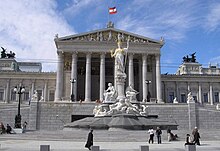Austrian politics
Austria is a federal, democratic republic governed under a constitution dating from 1920, though later amended.
Constitutional principles
The Austrian Constitution (in German: Österreichische Bundesverfassung) is the body of all the constitutional laws of the Republic of Austria at the federal level. It is divided into many different records. Its central piece is the Federal Constitutional Law (the Federal Constitutional Law)Bundes-Verfassungsgesetz), which includes the most important federal constitutional provisions.
In addition to B-VG, there are many other constitutional records (called Bundesverfassungsgesetzein singular Bundesverfassungsgesetz, abbreviation, BVG, i.e. without the script) and the individual provisions in the statutes and treaties designated as constitutional (Verfassungsbestimmung). For example, the B-VG does not include a declaration of rights, but the provisions on civil liberties are divided into different constitutional legislative acts.
Over time, both the B-VG and the numerous constitutional laws that supplement it have suffered literally hundreds of minor and larger amendments and revisions.European level
On July 17, 1989, Austria applied to join the then-current European Economic Community (EEC). On June 12, 1994 there was a referendum on Austria's accession to the European Union (EU), which was adopted with two thirds (66.58%) of the votes cast. The accession treaty was signed on June 24. Accession took place on January 1, 1995. In early 1999, Austria and eleven other member states joined the eurozone.
As a result of joining the EU, the Union was given various powers, most notably in business, agriculture, transportation, environmental protection, energy policy, and consumer protection. European law takes precedence over national legal systems. While regulations (de facto EU laws) are directly applicable, directives (EU framework laws, under which national laws will be enacted) only need to be transposed into Austrian law; If implementation does not take place within the usual time frames, a policy may also be directly applicable. EU Member States work together in politically "sensitive" of justice and security.
Since the entry into force of the Lisbon Treaty on December 1, 2009, Austria had 19 members in the European Parliament until 2013 (previously 17) and 18 seats since the 2014 European elections. the EU nominates a member of the European Commission. Since 2019, the Austrian Johannes Hahn has been the European Commissioner for Budget and Administration.
Federal level
Legislative branch
The Parliament of Austria (Österreichisches Parlament) is composed of two cameras:
- Nationalrat (national council) and
- Bundesrat (federal council).
The composition of the Nationalrat is determined every four years through general elections. The national council is the dominant chamber in Austrian legislation.
The Bundesrat is made up of the individual Landtagens. (Parliament of the States of the Federal Republic). The Bundesrat has the right to a dilation veto in many cases, which only a strong and persistent resolution of the national council can ratify.
The Bundesversammlung consists of members of both chambers of parliament and meets only on a few occasions.
The parliament building is the Ringstraße in Vienna. It is one of the most famous and central buildings in the city and was built during the government of Theophil von Hansen in the 1874-1883. Hansen focused on a classical Greek-style building, the Austrian government headquarters. In front of the Parliament building, you will find the statue of the goddess of the wisdom of Greek mythology, Pallas Atenea. During the Austro-Hungarian monarchy, the building housed the Reichsrat de Cisleitania.National Council
Federal Council
The Federal Council (in German: Bundesrat) is one of the two chambers of the Austrian Parliament. According to the Austrian Constitution, the Federal Council shares the legislature as the High House with the National Council of Austria (Nationalrat).
The Bundesrat is the state representation chamber and one of its characteristics is that its members are not bound by the voting discipline, being able to vote individually what they consider, which differentiates it from the German Bundesrat.
Its members are elected by parliaments of each State (Landtag), in proportion to their composition, for periods of 5 to 6 years. At least one senator must represent the majority minority of each Landtag. The number of delegates per state is between three and twelve, according to their population.Executive Branch
Chancellor of Austria
Judicial branch
Constitutional Court
State level political system
Austria is divided into nine federated States (Bundesländereach of them with their own central government. The capital, Vienna, is a state that covers only the municipality.
The country ' s political-administrative organization underwent major changes throughout the twentieth century. First because of the disintegration of the Austro-Hungarian Empire, later because of the Anschluss and finally after the events that followed the end of World War II.History
For decades, there were two major political parties: the Social Democratic Party and the Popular Party, which formed the government under a social pact that provided stability, based on a political culture of commitment and dialogue.
In recent times, great changes have been produced by greater mobility of the electorate, increased competition between parties and greater political dynamism. All this encouraged by the media. The parliamentary elections in October 2000 significantly transformed the Austrian political landscape, with three powerful parties emerging from the elections: the Social Democratic Party (Sozialdemokratische Partei Österreichs), the People's Party (Österreichische Volkspartei) and the Austrian Freedom Party (Freiheitliche Partei Österreichs). The last two united in a coalition and formed a government. The other two parties with representation in the Nationalrat are The Greens (Die Grünen) and the Union for the Future of Austria (Bündnis Zukunft Österreich), the latter born from a split of the FPÖ.
Social Pact
The social peace that Austria is experiencing rests on a specifically Austrian institution, the Social Pact, made up of business representatives (presidents of the Federal Chamber of Economy and the Federal Chamber of Agriculture) and worker representatives (presidents of the Confederation of Trade Unions and the Federal Chamber of Workers; see also: Social State).
This pact explains low unemployment rates and few labor strikes.
The combination of democracy, market economy and social pact has led to the creation of a typical Austrian political system, based on a climate of general consensus and collaboration between the different political blocks.
Contenido relacionado
Flag of the Central African Republic
Class system
Guatemalan foreign relations



